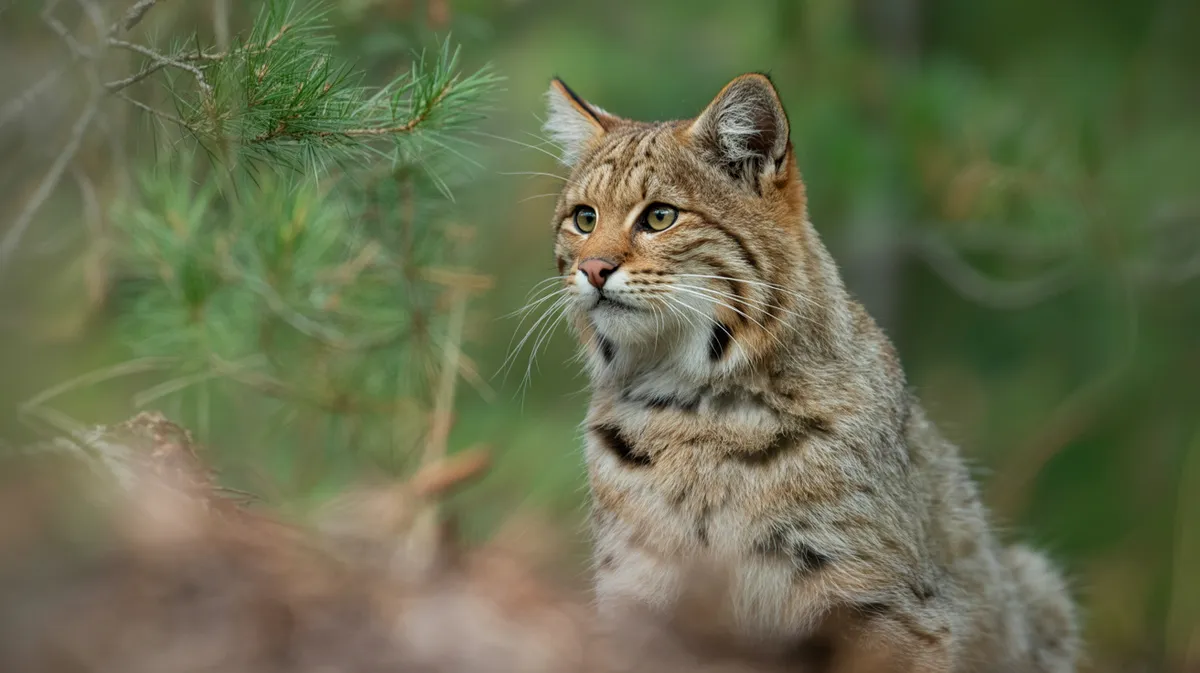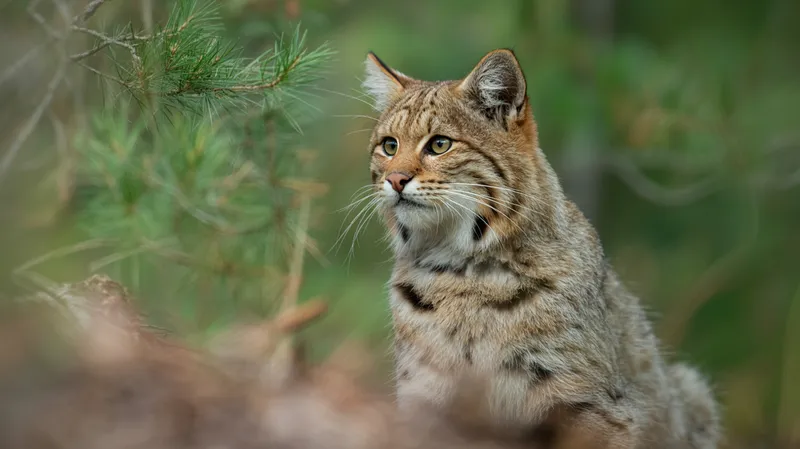
European Wildcat
Felis silvestris

Meet the European Wildcat
The European Wildcat is a medium-sized, elusive feline native to forests and woodlands across Europe. It is characterized by its robust build, bushy tail with a blunt black tip and distinct dark rings, and a dense, grey-brown fur coat with faint stripes. Unlike domestic cats, European Wildcats have a broader head and a more muscular frame, adapted for a solitary and territorial lifestyle. They are primarily nocturnal and are skilled hunters, preying mainly on small mammals and birds. Despite their once widespread range, they are now fragmented and threatened by habitat loss and hybridization with domestic cats.
Classification
Mammal
Habitat
Temperate forests
Diet
Carnivore
Lifespan
10-15 years
Conservation
Least Concern
Weight
3-8 kg
📖Fascinating Facts
Forest Dweller
European Wildcats primarily inhabit dense forests and woodlands, preferring areas with plenty of cover and low human disturbance.
Expert Hunter
Their diet consists mainly of small mammals like mice, voles, and rabbits, but they occasionally eat birds, reptiles, and amphibians.
Hybridization Threat
Hybridization with domestic cats poses a major threat to the genetic purity of the European Wildcat population.
📋Detailed Description
The European wildcat (Felis silvestris) is a robust, medium-sized felid, typically measuring 45–65 cm in head-body length, with a tail length of 25–35 cm and weighing between 3–7.5 kg, though males are generally larger than females. Its dense, plush fur is greyish-brown to tawny, with a distinct pattern of dark stripes along the body, legs, and especially the forehead, and a bushy, blunt-tipped tail marked by 2–5 black rings and a solid black tip. The skull is broader and more rounded than that of domestic cats, with pronounced zygomatic arches and strong jaw musculature, reflecting its adaptation to predatory life. The European wildcat possesses acute senses of hearing, sight (including night vision via a tapetum lucidum), and smell, which are vital for its crepuscular and nocturnal hunting habits. It is a solitary and territorial species, with individuals maintaining exclusive home ranges that vary from 1.5 to over 10 km² depending on habitat quality and prey availability. The wildcat is highly elusive, utilizing dense undergrowth, forest edges, and woodland mosaics for cover and ambush hunting. It is an obligate carnivore, feeding primarily on small mammals such as voles, mice, and rabbits, but will also take birds, reptiles, amphibians, and occasionally insects. The species is well-adapted to temperate forests but can also be found in Mediterranean scrub, mountainous regions, and, less commonly, open farmland with sufficient cover. Despite its superficial resemblance to domestic cats, the European wildcat is genetically, morphologically, and behaviorally distinct, with hybridization posing a significant conservation concern.
💡 Did you know?
The European Wildcat is one of the ancestors of the modern domestic cat, but it remains genetically distinct and does not readily interbreed in the wild.
🔬Research & Sources
Wikipedia Summary
The European wildcat is a small wildcat species native to continental Europe, Great Britain, Turkey and the Caucasus. Its fur is brownish to grey with stripes on the forehead and on the sides and has a bushy tail with a black tip. It reaches a head-to-body length of up to 65 cm (26 in) with a 34.5 cm (13.6 in) long tail, and weighs up to 7.5 kg (17 lb).
Last Modified: 5/17/2025
🎭Behavior & Social Structure
European wildcats are predominantly solitary and strictly territorial, with males and females occupying overlapping but exclusive ranges except during the breeding season. They are largely nocturnal or crepuscular, becoming most active during twilight and nighttime hours, and spend daylight hours resting in dense vegetation, hollow logs, or abandoned burrows. Their hunting strategy is primarily stalk-and-pounce, relying on stealth and patience to approach prey within striking distance. They are opportunistic feeders, with diet composition varying seasonally and regionally based on prey abundance. Communication is achieved through scent marking (urine, feces, and glandular secretions), vocalizations (growls, hisses, meows), and visual cues such as tail posturing. Social interactions are minimal outside of mating and maternal care, with aggressive encounters between adults being rare but potentially violent. Wildcats exhibit site fidelity, often using the same resting and denning sites for extended periods.
👶Reproduction & Life Cycle
Breeding in European wildcats typically occurs once per year, with the mating season spanning from January to March, though timing can vary with latitude and local climate. Females come into estrus for 2–8 days and may mate with multiple males. After a gestation period of 63–68 days, females give birth to litters of 2–5 kittens, usually in secluded dens such as hollow trees, rock crevices, or dense thickets. Kittens are born blind and helpless, weighing around 80–120 grams, and their eyes open after 9–12 days. The mother provides all parental care, nursing the young for 6–8 weeks and introducing them to solid food at about one month old. Juveniles begin to accompany the mother on hunting trips at 8–10 weeks and are typically independent by 5–6 months, although dispersal may be delayed until the following spring. Sexual maturity is reached at around 10–12 months.
🛡️Adaptations & Survival
European wildcats possess several adaptations for survival in temperate and mixed woodland environments. Their cryptic coloration and dense fur provide camouflage and insulation against cold climates. The bushy tail aids in balance and can be wrapped around the body for warmth. Acute night vision, sensitive vibrissae, and highly developed auditory faculties enable effective nocturnal hunting. Their retractile claws and muscular limbs facilitate climbing, leaping, and capturing agile prey. Behavioral adaptations include solitary, territorial living to reduce competition and the use of scent marking for communication. Wildcats exhibit seasonal flexibility in diet and activity patterns, allowing them to exploit fluctuating prey populations.
📚Research Sources
🎨Cultural Significance
The European wildcat has featured in European folklore and mythology as a symbol of wilderness, independence, and untamed nature. In some regions, it was historically regarded as a pest or threat to poultry, leading to persecution. Conversely, its elusive nature and role as a top small predator have earned it respect and protection in modern conservation culture. The wildcat is a flagship species for forest conservation in several European countries and is featured in local heraldry, literature, and environmental campaigns.
🔬Recent Research & Discoveries
Recent genetic studies using mitochondrial DNA and microsatellite markers have clarified the distinction between European wildcats and domestic cats, aiding in the identification of hybrids and pure populations. Camera trap surveys and radio telemetry have provided new insights into home range size, habitat preferences, and population densities, revealing that wildcats can persist in fragmented landscapes given sufficient cover and prey. Ongoing research focuses on the impacts of hybridization, disease ecology, and the effectiveness of habitat corridors in promoting gene flow. Conservation genetics projects in Scotland, Germany, and the Iberian Peninsula are particularly active, with efforts to map genetic purity and inform reintroduction or reinforcement programs.
🎥Wildlife Videos

Wildlife - Just Wild Cats | Free Documentary Nature
Wildlife - Episode 9: Just Wild Cats | Wildlife Documentary Watch 'Wildlife - Episode 10' here: https://youtu.be/44sC84_9Cbc Sleek ...
Free Documentary - Nature

Scottish ‘Highland Tiger’ wildcat more endangered than Asian cousin - BBC
The Highlands may appear a wild and unforgiving place, but for millennia people have lived alongside wild animals here, sharing ...
BBC

Wildcats - The Americas | Free Documentary Nature
Wild Cats - Episode 2: The Americas | Wildlife Documentary Watch 'Wild Cats - Episode 3' here: https://youtu.be/LBNk20Efvf8 The ...
Free Documentary - Nature

Wildcats - A Global Journey | Full Series | Free Documentary Nature
Wildcats - A Global Journey | Full Series | Wildlife Documentary Watch 'Wild Canada - Nature's Untamed Beauty | Full Series' ...
Free Documentary - Nature

Wildcats - Africa | Free Documentary Nature
Wild Cats - Episode 1: Africa | Wildlife Documentary Watch 'Wild Cats - Episode 2' here: https://youtu.be/0UsFwrM-YGA Africa, the ...
Free Documentary - Nature

Wildlife Instincts: Pallas's Cat - Master of the Plains | Free Documentary Nature
Wildlife Instinct - Episode 1: Pallas's Cat - Master of the Plains | Free Nature Documentary Watch "Wildlife Instincts: Survival ...
Free Documentary - Nature
🌍Habitat Information
The European Wildcat typically inhabits Temperate forests environments. European Wildcats have adapted to their environments with specialized features and behaviors.
Primary Habitat:
Temperate forests
More detailed habitat information will be available soon.
🛡️Conservation Status
The European Wildcat is currently classified as Least Concern. Conservation efforts are crucial for preserving this species for future generations.
Common Threats:
- 🏠Habitat loss and fragmentation
- 🌡️Climate change impacts
- 🎯Hunting and poaching
- 🏭Human-wildlife conflict
⚠️Threats & Conservation Challenges
The primary threats to European wildcats include habitat loss and fragmentation due to deforestation, agricultural expansion, and urbanization, which isolate populations and reduce genetic diversity. Hybridization with free-ranging domestic cats (Felis catus) is a significant conservation concern, leading to genetic introgression and dilution of wildcat lineages. Disease transmission from domestic cats, such as feline leukemia and feline immunodeficiency virus, poses additional risks. Road mortality, illegal hunting, and persecution (often due to mistaken identity or perceived threat to game species) further impact populations. While the species is currently listed as Least Concern by the IUCN, local populations in Western and Central Europe remain vulnerable, and ongoing conservation efforts focus on habitat connectivity, genetic monitoring, and public education.
🔬Scientific Classification
Scientific Name
Felis silvestris
Classification Hierarchy
🔍 About Taxonomic Classification
Taxonomic classification is a hierarchical system used by scientists to classify and organize living organisms based on shared characteristics and evolutionary relationships.
The system moves from broad categories (Kingdom) to increasingly specific ones, with each animal's scientific name typically consisting of its Genus and species.
📝Community Notes
Share your observations and insights about the European Wildcat with our community of wildlife enthusiasts.
Join Our Community
Sign in to share your observations and connect with fellow wildlife enthusiasts.
Sign In to ContributeNo community notes yet
Be the first to share your observations about the European Wildcat!
Explore European Wildcat
Select a tab above to learn more about this amazing animal.
📸Photo Gallery
No photos available for this animal yet.
🌟Discover More Wildlife
Continue your journey of discovery with more fascinating animals from our database
